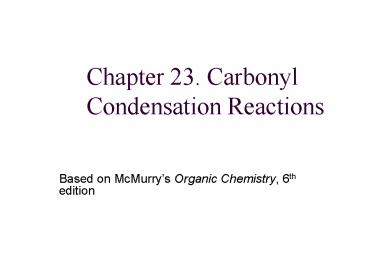Chapter 23' Carbonyl Condensation Reactions PowerPoint PPT Presentation
1 / 30
Title: Chapter 23' Carbonyl Condensation Reactions
1
Chapter 23. Carbonyl Condensation Reactions
- Based on McMurrys Organic Chemistry, 6th edition
2
Condensation Reactions
- Carbonyl compounds are both the electrophile and
nucleophile in carbonyl condensation reactions
3
23.1 Mechanism of Carbonyl Condensation Reactions
- Carbonyl condensation reactions utilize
?-substitution steps - An enolate ion adds as a nucleophile to the
electrophilic acceptor
4
23.2 Condensations of Aldehydes and Ketones The
Aldol Reaction
- Acetaldehyde reacts in basic solution (NaOEt,
NaOH) with another molecule of acetaldhyde - The b-hydroxy aldehyde product is aldol (aldehyde
alcohol) - This is a general reaction of aldehydes and
ketones
5
The Equilibrium of the Aldol
- The aldol reaction is reversible, favoring the
condensation product only for aldehydes with no ?
substituent - Steric factors are increased in the aldol product
6
Aldehydes and the Aldol Equilibrium
7
Ketones and the Aldol Equilibrium
8
Mechanism of Aldol Reactions
- Aldol reactions, like all carbonyl condensations,
occur by nucleophilic addition of the enolate ion
of the donor molecule to the carbonyl group of
the acceptor molecule - The addition intermediate is protonated to give
an alcohol product
9
23.3 Carbonyl Condensation Reactions versus
Alpha-Substitution Reactions
- Carbonyl condensations and ? substitutions both
involve formation of enolate ion intermediates - Alpha-substitution reactions are accomplished by
converting all of the carbonyl compound to
enolate form so it is not an electrophile - Immediate addition of an alkyl halide to
completes the alkylation reaction
10
Conditions for Condensations
- A small amount of base is used to generate a
small amount of enolate in the presence of
unreacted carbonyl compound - After the condensation, the basic catalyst is
regenerated
11
23.4 Dehydration of Aldol Products Synthesis of
Enones
- The ?-hydroxy carbonyl products dehydrate to
yield conjugated enones - The term condensation refers to the net loss of
water and combination of 2 molecules
12
Dehydration of ?-Hydoxy Ketones and Aldehydes
- The ? hydrogen is removed by a base, yielding an
enolate ion that expels the ?OH leaving group - Under acidic conditions the ?OH group is
protonated and water is expelled
13
Driving the Equilbrium
- Removal of water from the aldol reaction mixture
can be used to drive the reaction toward products - Even if the initial aldol favors reactants, the
subsequent dehydration step pushes the reaction
to completion
14
23.6 Mixed Aldol Reactions
- A mixed aldol reaction between two similar
aldehyde or ketone partners leads to a mixture of
four possible products - This is not useful
15
Practical Mixed Aldols
- If one of the carbonyl partners contains no ?
hydrogens and the carbonyl is unhindered (such as
benzaldehyde and formaldehyde) it is a good
electrophile and can react with enolates hen a
mixed aldol reaction is likely to be successful - 2-methylcyclohexanone gives the mixed aldol
product on reaction with benzaldehyde
16
Mixed Aldols With Acidic Carbonyl Compounds
- Ethyl acetoacetate is completely converted into
its enolate ion under less basic conditions than
monocarbonyl partners - Aldol condensations with ethyl acetoacetate occur
preferentially to give the mixed product
17
23.7 Intramolecular Aldol Reactions
- Treatment of certain dicarbonyl compounds with
base produces cyclic products by intramolecular
reaction
18
Mechanism of Intramolecular Aldol Reactions
- Both the nucleophilic carbonyl anion donor and
the electrophilic carbonyl acceptor are now in
the same molecule. - The least strained product is formed because the
reaction is reversible
19
23.8 The Claisen Condensation Reaction
- Reaction of an ester having an ? hydrogen with 1
equivalent of a base to yield a ?-keto ester
20
Mechanism of the Claisen Condensation
- Similar to aldol condensation nucleophilic acyl
substitution of an ester enolate ion on the
carbonyl group of a second ester molecule
21
23.9 Mixed Claisen Condensations
- Successful when one of the two ester act as the
electrophilic acceptor in reactions with other
ester anions to give mixed ?-keto esters
22
Esters and Ketones
- Reactions between esters and ketones, resulting
in ?-diketones - Best when the ester component has no ? hydrogens
and can't act as the nucleophilic donor
23
23.10 Intramolecular Claisen Condensations The
Dieckmann Cyclization
- Intramolecular Claisen condensation
- Best with 1,6-diesters (product
5-membered?-ketoester) and 1,7-diesters
(product 6-membered ?-ketoester)
24
Mechanism of the Dieckmann Cyclization
25
23.11 The Michael Reaction
- Enolates can add as nucleophiles to
?,?-unsaturated aldehydes and ketones to give the
conjugate addition product
26
Mechanism of the Michael Reaction
- Nucleophilic addition of a enolate ion donor to
the ? carbon of an ?,?-unsaturated carbonyl
acceptor
27
Generality of the Michael Reaction
- Occurs with a variety of ?,?-unsaturated carbonyl
compounds (aldehydes, esters, nitriles, amides,
and nitro compounds) - Donors include ?-diketones, ?-keto esters,
malonic esters, ?-keto nitriles, and nitro
compounds - See Table 23.1
28
23.12 The Stork Enamine Reaction
- Enamines are equivalent to enolates in their
reactions and can be used to accomplish the
transformations under milder conditions - Enamines are prepared from a ketone and a
secondary amine
29
Why Enamines Are Nucleophilic
- Overlap of the nitrogen lone-pair orbital with
the double-bond p orbitals increases electron
density on the ? carbon atom
30
Enamine Addition and Hydrolysis
- Enamine adds to an ?,?-unsaturated carbonyl
acceptor - The product is hydrolyzed to a 1,5-dicarbonyl
compound

